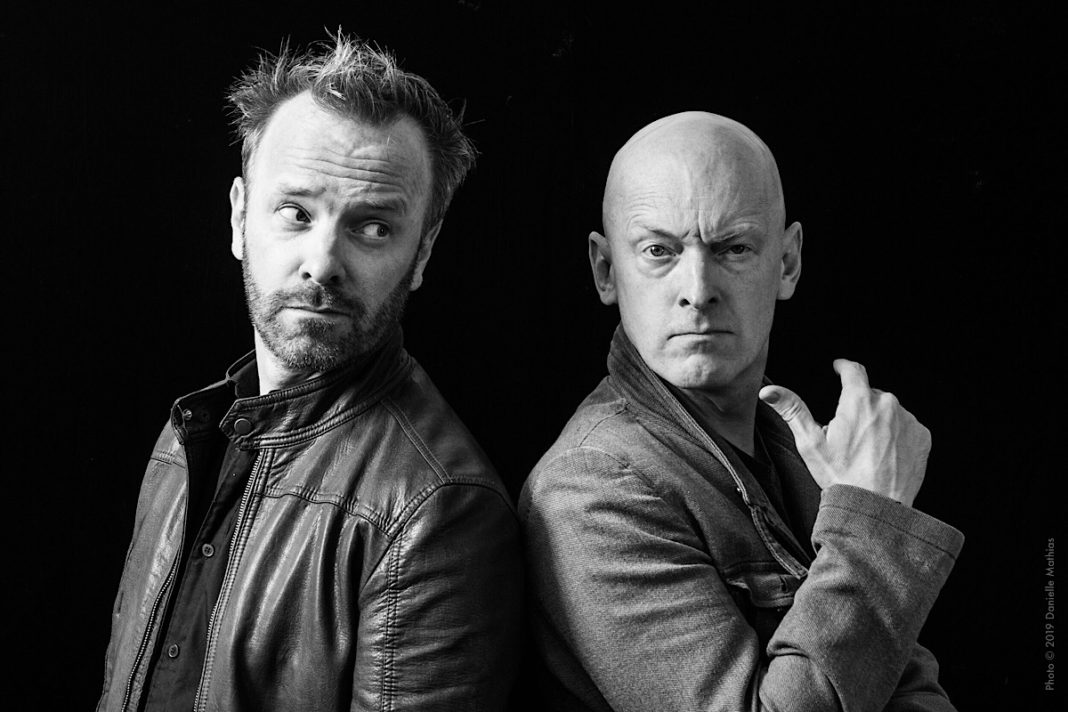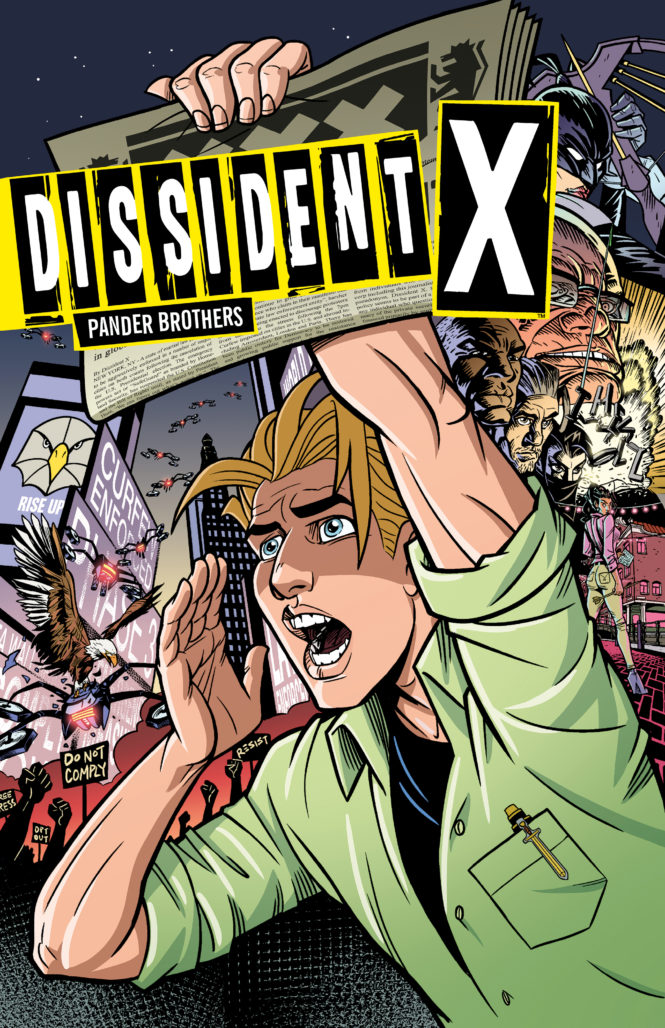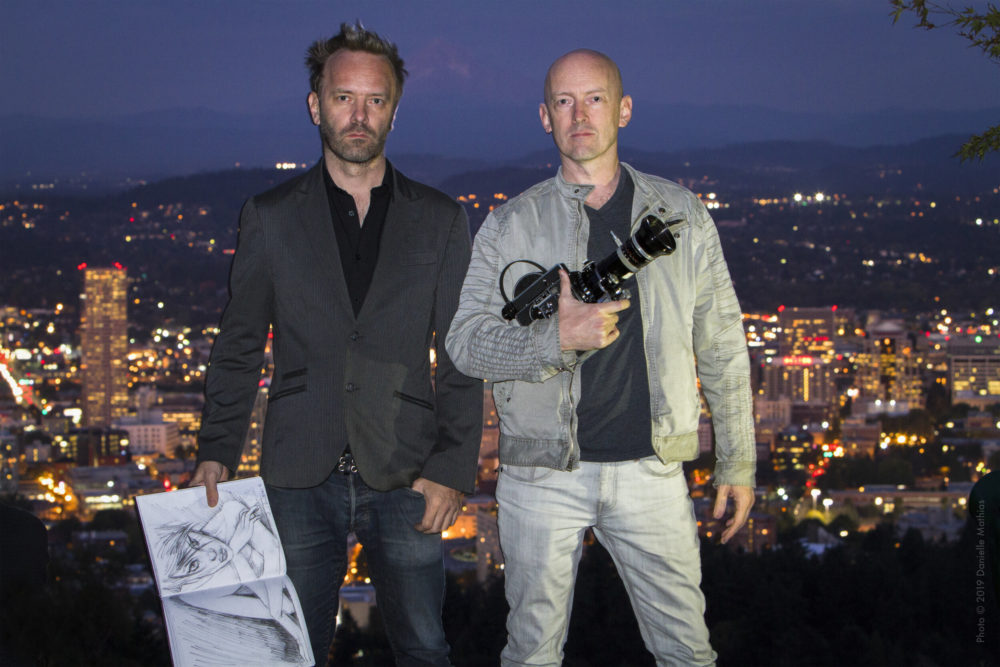If politics and conspiracies come knocking on the door, count on Arnold and Jacob Pander, a.k.a the Pander Brothers, to be the eyes on the street. In Dissident X, the Pander Brothers have taken their collective experiences and put together a story that seems ripped from the political headlines. The Pander Brothers explore what happens in a society where corporate interests have usurped democratic values. The Pander Brothers sat down with The Beat to talk 45 (He Who Must Not Be Named), alien abduction and how their Dutch resistance roots shaped the story then and now.
Nancy Powell: How eerie is it that your 1994 Dark Horse comic series, Triple-X International, would become so prophetic 25 years later?
Jacob Pander: In retrospect many of the signs were already there, wars igniting over corporate interests and oil, eco-terrorism and information warfare. Sparks were setting the kindling alight, but who knew how quickly the fire would get out of control.
Arnold Pander: Many of the themes in the story were direct responses to things we were seeing and experiencing around us as we were becoming politically aware, being that we were in our early twenties at the time. We saw the potential of governments becoming more and more impacted by economic influences, and thought, ‘Wow one day maybe a charismatic business mogul will be running the government,’ which inspired the character of Thexoll. The fears of corporate control of natural resources like water, where the lifting of environmental protections seemed like a very realistic issue that we’d be facing in the 21st century. Unfortunately that, along with climate change, are coming true as well.
Powell: Did your decision to expand the original comic have anything to do with the results of the 2016 election?
Jacob: We had actually embarked on expanding the story the year before the election. We knew that we wanted to remaster and color the book and at minimum release it digitally. But since the original storyline was written in the 90’s before the advent of social media and smart technology, we wanted to come up with an inventive way to recognize that aspect of our envisioned near-future so we set out to write a prequel that set the stage for our protagonist Hans’ dealing with a society that has become a surveillance state, and giving rise to the story’s “Opt Out” resistance movement. These concerns were part of the story before the election, as we had already seen with Edward Snowden’s revelations.
Arnold: The election gave our reboot effort more palpability as the new administration rolled back ecological protections and awarded massive tax cuts to the wealthy and 45 continues to make chilling attacks on the free press and other pillars of our democracy. Much of the new storyline places emphasis on the ongoing attacks to journalism, which gave our protagonist Hans more tension as he feels the inherent desire to expose the truth of the corruption he witnesses while also being on the run as an exiled journalist without a country – a Dissident.
Powell: Did George Orwell’s 1984 figure into any of this?
Arnold: In some ways it did. When we were first developing the story and antagonist, the concept of a “Big Brother” type of dictator was paralleling what was happening under Reagan and later Bush with censorship of music and films at the time. There was a kind of paranoia that a police state was always a possibility if the powers that be felt that threatened by counter-cultures that were using the platform of arts through pop culture to point out the injustices around the world. Basically Gen X was coming of age with the fears that George Orwell had predicted. Even his verbiage, “Do not believe what you see and hear” was used nearly verbatim in one of 45’s rallies, so it’s all still very relevant. As we became more socially conscious, we began to wonder how we could work some of these themes into the comics we were doing. It was kind of the perfect time for it.
Jacob: The inspiration for the original story happened in a bar in Amsterdam way back in 1986. We were drawing our first national series, Grendel, for Comico and we had flown to Amsterdam to visit our family for the first time since we’d been born there. We had grown up reading the Belgian comic book, Tin Tin, about the international adventures of a boy reporter. As we sat there in our early 20s feeling like we were on our own international adventure, we thought it would be cool to create a modern adventurer but one that was dealing with contemporary issues both socially and politically. Also the experience of being in this 14th century city, we recognized that we were already in Amsterdam’s far future, and that it will probably look very similar a hundred years from now. We wanted the story to exist slightly out of our time in a near future that felt grounded and relatable to our time, but also had certain future-forward sci-fi aspects to it. The original take was much more romantic, like a 30s adventure book, but upon our return to America political unrest began to unfold around the writing of the project with the onset of the first Gulf War and global protests to what was believed to be a war for oil, so that mood began to seep into the story and setting.
Powell: How much research did you do historically to bring this story to life?
Jacob: We lived off and on in Amsterdam for a period of three years during the writing and penciling of the original 336 page story. We spent a lot of time soaking up the streets and lore of the city, some of which found its way into our story. We were introduced to the Dutch underground squatter scene that was taking over buildings to live in with some having ties to the more radical underground political elements. This set the tone for the characters who eventually give refuge to our protagonist Hans while he is hiding out in Amsterdam.
Arnold: The echoes of WWII and the Nazi occupation Holland are still deeply etched in the Dutch consciousness. The stories we heard about the Dutch resistance inspired and informed the character of Willem, who was once the printer of a legendary underground newspaper in the story. We worked in the resistance tunnels that are used to distribute the paper XXX that the original series title was based. The Dutch population suffered greatly under Nazi occupation so the notion of a powerful and oppressive force that is anti-democratic in nature felt palpable there and definitely influenced the tone of the story.
Powell: Was Hans Nobel, the main character in the Dissident X, inspired by any particular historical figure?
Jacob: In many ways there is an autobiographical aspect to the story. We knew at the time that we wanted to connect with the Dutch side of our family. Our mother is American and met our father while traveling in Amsterdam in the early 60s. We’d grown up in Portland, Oregon, and were ready to throw ourselves into the world and begin our own adventures. We came up with the idea of moving to Amsterdam and setting our story there, and in doing so learned more about our grandfather, who was an artist himself and had illustrated resistance newspapers during World War II that were illegally circulated amongst the Dutch population during the Nazi occupation of Holland. Our family home would sometimes be used as a safe house for resistance members to hide and take refuge in, so there’s some irony that Hans, a U.S. citizen, is now in need of refuge by the Dutch.
Arnold: Hans is also the archetype of a global citizen who is seeking answers to the problems we face in society, caught in the middle between these forces and trying to sort out what path to take toward a more just world. He is a contemporary version of many archetypes in history who have attempted the same.
Powell: Hans is in constant motion throughout the story, whether by his own doing or as a direct result of his circumstances. What went into developing these scenes conceptually?
Arnold: That’s an interesting observation. I think we’ve always been attracted to stories that keep you turning the page. We were influenced by stories of a hero on the run, be it Luke Skywalker wanting to save the princess or Cary Grant trying to clear his name in North By Northwest. We’ve always been attracted to stories that have you on the edge of your seat.
Powell: Which artists’ works or stories influenced how the Pander Brothers approached Dissident X?
Jacob: We wanted the feel of the book to have more of an illustrated feel and tap some of those great European comics influences like Herge, Joost Swarte, Ever Muellen, Milo Manara, Enki Bilal and Liberatore among others.
Arnold: Jacob’s true-to-life architecture became extremely detailed and are based on actual locations for the most part. The figures, I felt in hindsight, were a bit overworked, particularly the faces and hands so for this remastered version I decided to revise them, using the original artwork as the basis but essentially redrawing many of them digitally on the Cintiq. This also added a lot more labor to the effort but hopefully gives the book a more up-to-date feel.
Powell: Whose idea was the parallel prison story? The coloring—black, white and brown—feels like it’s being told from a historical standpoint.
Arnold: We thought a parallel story that was a kind of raw third world narrative that connected to the main first world story of Hans might illuminate how even though there are those in far away places that we may never meet, that we are all connected by the global mechanism and by a common desire for freedom and justice.
Jacob: One interesting encounter that we had while living in Amsterdam that had a strong impact on the book, was meeting two South African ANC warriors in a bar one night. They described how they had snuck out of South Africa to be trained by the Soviet military in guerrilla warfare and were now on their way back to one of the bordering countries of South Africa to sneak back into their homeland to rejoin the ANC and support Nelson Mandela’s anti-apartheid movement. Their story informed the subplot of the young girl on the island that becomes a militant due to the extreme conditions of her oppression.
Powell: Since Dissident X abounds in conspiracy theories, can you tell me what conspiracy theory in modern history has fascinated you the most?
Jacob: It seems like conspiracy theories were always part of life, growing up with the real life conspiracies surrounding the Kennedy assassination, the mystery of Sasquatch and watching Mission Impossible and 007 movies. Three Days of the Condor was also influences. In Dissident X we wanted to come up with a corporate conspiracy that would have a good reveal and that had some real practical benefits for the bad guys to help them vilify our protagonist Hans.
Arnold: I’ve always been interested in alien abduction and the conspiracies around Area 51. Once we drove to Area 51 and got about as close as one can get. We were just below the white Bronco where a Special Forces person has permission to fire on anyone who dares step past the warning signs. There was no security gate, just a grazing cow who stared at us like we were aliens. Still not sure how we got that close. We actually have a fun project in the works that does a take on alien conspiracies.
Powell: You’ve worked on Batman titles of DC. If you had the chance to work on another superhero title, which would you choose and why?
Arnold: For Marvel it would be Iron Man since that’s the first comic character I got into as a kid. Always loved the tech and the geopolitical conflicts. I would work on Madam Masque or Black Widow since they are both such badass female characters. For DC, Catwoman or Superman. We also have another Batman tale up our sleeves.
Jacob: I’m a big fan of Alex Raymond’s Flash Gordon and actually pitched a couple ideas to Dynamite a while back, including a Vampirella story. Would love to resurrect one of the classics.
Powell: What is your favorite superhero movie?
Arnold: Iron Man with RDJ is my fave guilty pleasure. Artistically, The Joker was absolutely brilliant but I almost felt that the comic book tie ins were kind of incongruous.
Jacob: Loved seeing the Rocketeer brought to life on the big screen, and still am riveted by Heath Ledger’s Joker in The Dark Knight.
Powell: What is your favorite science fiction movie?
Arnold: Star Wars : A New Hope with Blade Runner as a close second.
Jacob: Along with Arnold’s pics, I’d have to say Road Warrior and Fury Road are way up there, and I just revisited the original Terminator the other night, which was a blast to see again.
Powell: What books or graphic novels are you currently reading?
Arnold: The Maneaters series. It’s a really great concept and I love all the fake ads and female empowerment activities. Also picked up Folklords. The artwork by Matt Smith is really elegant.
Jacob: Bitter Root by David Walker and the new Grendel: Devil’s Odyssey which has some great color work by Brennan Wagner.
Powell: What future books can we expect to see from the Pander Brothers?
Arnold: We’ve written a followup story to our Dark Horse Book, GirlFIEND, a vampire crime thriller, which picks up in Paris where the last book left off.










